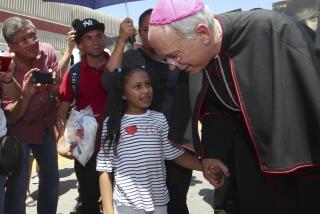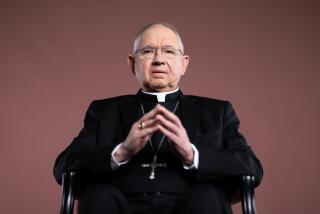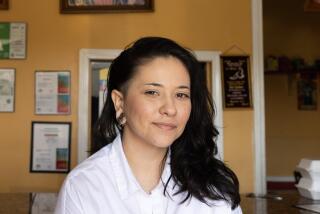It’s Latino Immigrants Who Can Save the Catholic Church
- Share via
One widely favored remedy for the sexual-abuse scandals rocking the American Catholic Church is for the church to adapt to the cultural mainstream. Priests should be allowed to marry. Catholic women should be ordained. Ironically, Catholic culture may already be too mainstream. Traditionally rooted in--and reinforced--by a powerful subculture, American Catholicism is paying the price of the assimilation of the immigrants that were once its lifeblood. The faithful are no longer eager to give their sons and daughters to the church.
The election of John F. Kennedy to the presidency in 1960 marked the symbolic end of a separate Catholic culture in America. The values and morality of the Irish, the immigrant group that long dominated the priesthood and the church hierarchy, and other Catholics are virtually indistinguishable from non-Catholic Americans today. The institutional church has remained at odds with contemporary secular American culture, but its congregants are immersed in it. By the 1970s, Catholicism as a way of life had retreated to behind church doors.
But another group of immigrants is bringing Catholicism back into our public lives and, in doing so, may help heal the broken American church. Newcomers from the south carry a less doctrinaire and more feminine faith, one embedded in a broader folk tradition and a stronger belief in the supernatural. The fusion of this kind of faith with the modernizing American church could reinvent Catholicism in the United States.
Although Mexicans have been a part of American Catholicism since the Southwest became U.S. territory in the mid-19th century, only today do their numbers ensure their effect on the broader faith. An estimated 80% of the increase in the number of U.S. Catholics occurred in the same six states where the Latino population has grown the most. Today, roughly one-third of American Catholics are Hispanic, most of them Mexican. In Los Angeles, now the largest archdiocese in the nation, two in every three Catholics is Latino.
On Good Friday, in many heavily Latino parishes around the country, the traditional solemn Mass gave way to a religious procession and dramatic reenactment of Christ’s final steps. Whether stopping traffic in Elgin, Ill., or shutting down intersections in San Antonio, Texas, the Way, or Road, of the Cross is a popular Latin American custom that is becoming an integral part of American religious life. The Irish bequeathed rigor and formalism to the American church. Mexicans and other Latin Americans bring new forms of public celebration that blur the line between the sacred and the secular.
For Mexicans, the church is not always the locus of their religious life. Much of Mexican religious practice is celebrated outside the church in the form of shrines, pilgrimages and front-yard altars. It’s not uncommon for grocery stores in the Southwest to stock devotional candles. Mexicans have kept alive the tradition of sidewalk shrines on the spot where people have died. Images of the Virgin of Guadalupe, the patron of Mexico, are painted on walls in Mexican neighborhoods throughout the country.
Old-World devotional practices to the Virgin or the saints are nothing new to American Catholicism. Earlier waves of Catholic immigrants, including previous generations of Mexicans, brought with them their own national and local devotional icons. A century ago, Italian immigrants celebrated the feasts of Our Lady of Mount Carmel and Our Lady of Pompeii. Each ethnic group venerated its own favorite holy men. The Irish honored St. Patrick, German Catholics St. Boniface and the Poles St. Stanislaus.
But the assimilation and mobility of white ethnic Catholics, combined with a movement to refocus attention on the rites and rituals of the formal church, led to a decline in devotional Catholicism after the 1950s. The stature of the Virgin Mary began to disappear in American churches.
As they become a larger part of American Catholicism, Mexicans will likely reverse that decline. Of all the cultural and political icons that the Latinization of the United States has or is likely to contribute to American culture, none will be as powerful or as persistent as that of the Virgin of Guadalupe. Her feast day, Dec. 12, is already one of the Catholic calendar’s three most popular churchgoing days in Los Angeles and in other heavily Mexican dioceses in the country. Every year on that day, mariachis serenade her at dawn. And as immigrants have carried her image with them to previously unvisited parts of the country, the Virgin’s popularity has expanded well beyond her ethnic base.
A growing number of non-Mexican churches and causes have adopted the “Brown Virgin” as their own. St. Peter’s Catholic Church in Olney, Md., a suburban parish founded in 1798, has a large mural of Guadalupe. St. Michael’s in Grand Forks, N.D., whose parishioners are largely of Scandinavian and German descent, recently placed a statue of her in its schoolyard. A Canadian Bishop, Frederick Henry of Calgary, has proposed that Dec. 12 be made a holy day of obligation, a day Catholics are required to attend Mass. The Catholic pro-life movement has embraced Guadalupe as its patron. Last year, Jackson & Perkins, the world’s largest grower of roses, named a sweet smelling, silvery pink floribunda rose after her.
By reinvigorating devotion to Mary, Mexicans may be contributing to the feminization of an institution whose male-dominated culture is under attack. “Guadalupe is bringing to American Catholicism a very healthy sense of the maternal side of God,” says Father Virgilio P. Elizondo, a prominent Mexican American theologian. Devotion to Mary encourages nurture over strict observance.
Aizita Magana, who has studied Latina maternal and child health, contends that admiration for the Virgin contributes to unusually healthy birth outcomes among poor Mexican American women who have limited access to medical care. “Latinas, in particular, often see the Virgin as providing support and encouragement,” says Magana. “She is the ultimate maternal role model.”
Because Mexican religiosity stresses cultural practice over orthodoxy, some theologians believe their rising presence may tone down the polemics within the American Catholic Church. “The values of Hispanic culture tend to be communicated not by precise doctrine but through symbols,” says Father Allan Figueroa Deck, executive director of the Loyola Institute for Spirituality in Orange, Calif.
Acculturation is always a two-way street, however. Even as Mexicans wield greater influence in the American Catholic Church, America is changing them, too. South of the border, only a small percentage of Catholics attend Mass every Sunday, in part because Mexico has long suffered from a shortage of priests. Immigrants attend church more regularly as they acculturate into U.S. life. And just as latter-generation Mexican Americans are more likely to slip into mainline Protestant faiths than are immigrants, many more will be seduced by the power of secular logic.
Still, whether we share these same beliefs or not, the rise of popular and folk religious expressions in our modern public lives is likely to make us all ponder the power of traditional faith. The brand of Catholicism that rural Mexicans bring with them to the United States calls for different leaps of faith and allows for greater possibilities for miracles and the unexplainable. The American Catholic Church, which has become more rationalist and less devotional, could benefit by reabsorbing just a little bit more of this old-time religion.
More to Read
Sign up for Essential California
The most important California stories and recommendations in your inbox every morning.
You may occasionally receive promotional content from the Los Angeles Times.










